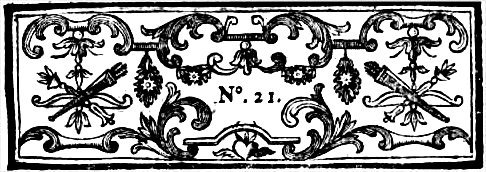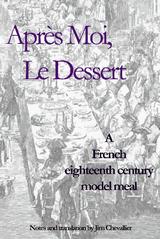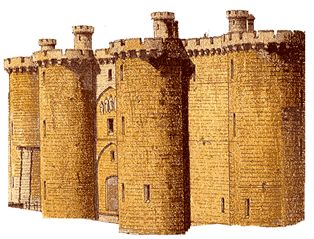From CHEZ JIM Books:
An EIGHTEENTH CENTURY VEGETARIAN COOKBOOK:
APRES MOI LE DESSERT - VOLUME II
and a history of the CROISSANT:
AUGUST ZANG AND THE FRENCH CROISSANT
|


18th CENTURY RECIPE: A meal for Marie-Antioinette - Fowl wings à la Maréchale
Continuing down the list from last week of sixteen entrees served in a meal
for Marie-Antoinette, the next three items are "Grilled mutton cutlets, Rabbits on the skewer, Fowl wings a la marechale...". There's not much to say about the first two, except that rabbits were usually larded before being cooked
on skewers and most often served with "water and salt" (brine?). "Fowl wings a la Marechale" requires more comment.
It seems to be a rule that a dish known today by its eighteenth century name will differ significantly from the original. Various preparations "à la Maréchale" can be found on the Net, and one cooking dictionary defines the preparation as "small cuts of meat and poultry which are breaded and fried in butter. Green asparagus tips and truffles are usual in the garnish." The Larousse Gastronomique gives a similar description. But the earliest recipe I can find (1814, in Beauvillier's L'Art du Cuisinier) lists none of these. Also the TLF says that the modern version is typified by the use of truffles, whereas the recipe below includes just one - which is decorative and entirely optional. (Similarly, one early recipe for Poulet Marengo says only to add a few spoonfuls of tomato sauce - while tomatoes are now the dominant ingredient in that dish.)
From the recipe below and another for an entire pullet, it seems that the eighteenth century version involved stuffing or larding the wings or bird and lightly browning and glazing it after cooking. No breadcrumbs, truffles optional.
Scented powder "à la Maréchale", created by the Maréchale d'Aumont (under Louis XIV), is also often mentioned, though unrelated to this recipe.
No source names the Marshal's wife for whom the recipe is named, though it's tempting to associate it with the Maréchale de Luxembourg (1707-1787), a patron of Rousseau's who was also a major society hostess and who Lytton Strachey says: "was obliterating a highly dubious past by a scrupulous attention to 'bon ton,' of which, at last, she became the arbitress: 'Quel ton! Quel effroyable ton!' she is said to have exclaimed after a shuddering glance at the Bible; 'ah, Madame, quel dommage que le Saint Esprit eut aussi peu de gout!' ['Ah, Madame, what a pity that the Holy Spirit had so little taste!' (JC)] Lytton Strachey, Books and Characters
Grimm (April 1776) quotes a verse on her when she was still Mme. de Boufflers:
Quand Boufflers parut a la cour,
On crut voir la mere de l'Amour;
Et chacun l'avait a son tour.
When Boufflers appeared at Court,
One thought to see the mother of Love*;
And each one had her in his turn.
*that is, Venus
This was very probably by the Count of Tressan, who got slapped for his pains.
Mme. Deffand said of her, when she was younger: "Mme. the Dutchess of Boufflers is beautiful without seeming to be aware of it... She is full of wit and gaiety; she is constant in her engagements, faithful to her friends, true, discreet, agreeable, generous; really, if she was less clear-sighted, or if men were less ridiculous, they would find her perfect." (quoted in Colomby's Ruelles, Salons et Cabarets, II-128) (Deffand's generous 'clear-sighted' - clairvoyante - might be a kind way of saying her subject could be quite sharp on occasion.)
The 'fowl' (volaille) in this case could have been any of a number of birds - the following recipe is more specifically for a fattened pullet (poularde) (Beauvilliers (I-329)):
Wings of Fattened Pullet à la Maréchale
Take three nice plump pullets, remove their wings, take off the tips, keeping only the stumps; lift the small skin on them, resting your wings on the table, and slipping your knife, as if you were lifting a strip of lard; be careful not to damage the skin; lard your six wings with a second [wing?], and set them out in a casserole, as indicated in the article for Medley of Fattened Pullets [(I-324) '....lay these four wings out in a casserole stuffed with lard strips, with a carrot, a bouquet of parsley and spring onion, and two onion halves, in one of which you will have put a clove nail; moisten your wings with a little consomme: be careful that this moisture does not reach the lard strips set into your pullets, and cover them with a round of paper; a quarter of an hour before serving, divide them, with a fire under and over them...']; your wings cooked, drain them on a cover; glaze them; they should be of a nice blond color; lay out in your dish a nice reduction of chicory; lay your six wings on this with the points touching in the center to the plate, forming a rosette; put, if you like, a nice truffle in the middle, and serve.

|






